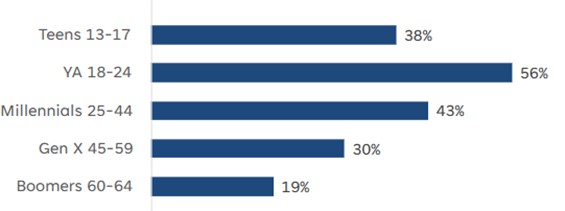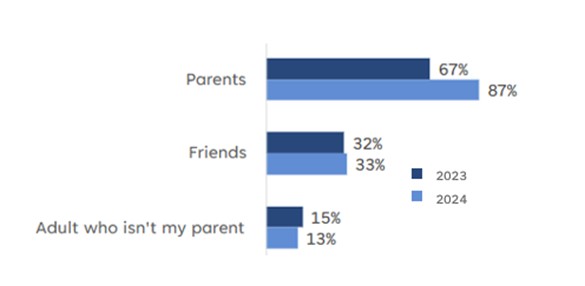With growing interest in emerging technologies such as generative AI, Safer Internet Day provides an opportunity for people of all ages to engage and discuss online activities and safety.
February 6, 2024 marks Safer Internet Day. It’s an annual event where people from around the world come together to create a safer and better online environment for everyone, especially young people. Microsoft has a long-standing commitment to children’s online safety, and as we recently outlined, we believe continued research is needed to continue evolving our approach. That’s why, as part of our continued participation in Safer Internet Day, we’re sharing the latest findings from our annual Global Online Safety Survey with two new resources to help parents engage with their children: Family Safety Tools Release kits and new educational games. From Minecraft.
Now in its eighth year, Microsoft’s annual survey aims to better understand people’s online experiences and inform our approach to digital safety. As we collectively strive to build a more secure digital ecosystem, we will share our results publicly so that others can benefit from our insights. With the launch of generative AI tools, this year’s research focused specifically on how people of all ages perceive the opportunities and risks posed by this emerging technology. Our research found:
Millennials and Gen Z are driving the adoption of generative AI, with familiarity and early adoption leading to greater excitement
The most active users and experimenters are young people (56%). The reasons respondents were most excited about using AI as a practical tool included translation purposes (43%), work (32%), and school (31%).

However, 87% of respondents are concerned about at least one potential risk from generative AI, including concerns about its use for fraud (71%) and deepfakes (69%). These concerns steadily increase with age, with Gen Z being the most concerned and baby boomers the least concerned.
Encouragingly, our research found that 87% of young people discuss online risks with their parents.However, further awareness of safety features and tools is required
Compared to the 2023 survey, results showed a 20-point increase in the number of teens who talked with their parents about online risks. In fact, young people are more likely to talk to their parents than to colleagues or friends.

While more teens are talking to their parents, our findings suggest that the use of safety features is decreasing. For example, the use of private accounts, the most popular safety feature in last year’s survey, fell from 64% in 2023 to 56% in 2024. Parental control usage rates remained stable, with 90% of parents reporting that he or she used at least one parental control. Female caregivers are the most active participants in their children’s online activities.
To learn more about our findings, download the full infographic here.
New online safety resources for youth, parents and educators
Enabling users and their families to make informed choices about their online activities will become even more important with the advent of generative AI. Importantly, our findings show that young people trust their parents and look to them for support and guidance regarding online risks. We’re launching two new online safety resources to help young people, educators, and families navigate the digital world. We also recently published a toolkit for students and educators to help them use generative AI in learning environments.
- Microsoft Family Safety Toolkit. We know that parents and caregivers are busy and that the technology landscape continues to evolve. This new toolkit provides guidance on how to leverage Microsoft safety features and family safety settings to support and enhance digital parenting, as well as guidance for families looking to navigate the world of generative AI together. To do. We also include links to carefully selected informational resources already created for parents, such as the Family Online Safety Institute’s How To Be A Good Digital Parent Toolkit.
- Minecraft Education’s “Good Game”. “Good Game” is the latest addition to the CyberSafe collection of immersive Minecraft worlds designed to help young people stay safe, happy, and thriving online. This adventure teaches players the responsibilities, tools, responses, and strategies that enable healthy online interactions, collaboration, and rewarding digital experiences, whether as part of multiplayer games or other online activities. Masu. The Cyber Safe collection is one of the most downloaded educational content on the Minecraft Marketplace, with over 25 million downloads by players around the world.
- Classroom Toolkit: Unleash generated AI safely and responsibly. Now available to educators, the Classroom Toolkit combines stories and instructional information to create immersive and effective learning experiences for students ages 13-15. This toolkit is designed to help start conversations about responsible AI practices in the classroom, including important topics such as content fabrication, privacy considerations, bias awareness, and mental health. Masu.
Microsoft remains committed to creating a safer online environment for everyone
We recognize our role as a technology company in protecting individuals, especially young people, from harmful and illegal online content and conduct. Safety by design is at the core of our products, and we remain committed to supporting and working closely with our industry, government and civil society partners to build a safer online world for everyone. I’m here.
Additional resources from Microsoft to enhance your online safety:
Report method
Starting in 2016, Microsoft has published annual data on how people of different ages use and view online technology. This latest consumer-based report is based on a survey of nearly 17,000 individuals conducted this summer in 17 countries* to understand people’s attitudes and attitudes towards online safety tools and online interactions. Investigating perceptions. Different countries treat online safety differently.Full results can be accessed here.

